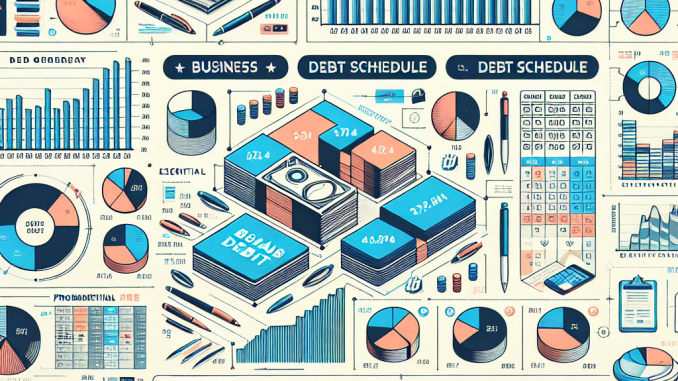
Unpacking the Essence of a Business Debt Schedule
When aiming for a bird’s-eye view of your company’s financial obligations, a business debt schedule becomes indispensable. Think of it as a ledger mapping out your enterprise’s long-term financial commitments. This detailed roster typically embraces:
- Term loans, equipment financing, and Small Business Administration (SBA) loans
- Contracts underpinning financial obligations
- Leases for assets—ranging from real estate to vehicles and equipment
- Notes payable and bonds
- Any recurring long-haul payments your business shoulders
It’s important to recognize that short-lived expenses, like quarterly taxes, payroll, or accounts payable, don’t make the cut here. By omitting these, your debt schedule sharpens the focus on the overarching weight your debt places on the business.
Why Craft a Business Debt Schedule? The Strategic Payoff
What sparks the creation of a debt schedule in your company’s playbook? It serves several cardinal functions that keep your financial ship steady:
- Sidestep Missed Payments: At its core, this schedule is your safeguard against slipping up on repayments. Missing dues or damaging your creditworthiness can dismantle your business faster than anticipated. Consolidating all dues in a single reference point helps you spotlight which debts to tackle first when extra cash flows in.
- Weigh Refinancing Options: Occasionally, renegotiating or refinancing your loans makes sense—to dodge overleveraging and preserve a healthy debt ratio.
- Present to Lenders and Investors: When courting financial backers, a transparent, well-documented debt schedule allows them to gauge your risk profile and willingness to repay.
- Balance Your Budgets Wisely: It paints a clear picture of how your debts slot into your overall budget, illuminating the revenue thresholds needed to service liabilities and ultimately generate profit.
Don’t let your debt schedule gather dust; keeping it refreshed is pivotal to unlock these advantages regularly.
Must-Haves on Your Business Debt Schedule
Curious about the anatomy of an effective debt schedule? Every entry should include crucial specifics such as:
- Creditor or Lender Identity: Banks, investors, credit unions, or other financial backers holding your debt.
- Initial Debt Amount: The principal sum your business borrowed at the outset.
- Origination Date: The moment your company first inked that debt.
- Outstanding Balance: What remains unpaid as of today.
- Interest Rate Applied: The percentage that dictates loan servicing costs.
Adding a notes section can be a masterstroke—recording the rationale behind taking on debt or any quirks in repayment terms, including fees like prepayment penalties.
As a savvy move, sort debts by their maturity date. This prioritizes imminent obligations and assists in managing the most urgent liabilities upfront.
Snapshot of Debt Schedule Data
| Triton Capital | $15,000 | 01/08/2023 | $14,179.30 | 8.20% | $305.58 / month | 01/08/2028 | Commercial oven |
| Bank of America | $100,000 | 02/01/2021 | $80,045.56 | 3.01% | $966.07 / month | 02/01/2031 | Personal guarantee |
| Bank of America LOC | $40,000 | 02/03/2021 | $500 | 18.00% | $45.84 / month | 02/03/2022 | Blanket lien on business assets |
| Truist Commercial Mortgage | $300,000 | 02/20/2020 | $270,000 | 8.00% | $2,509.32 | 02/20/2040 | Office building |
According to data from the SBA, approximately 27% of small businesses use SBA loans to finance growth, underscoring the importance of diligent debt management. Moreover, businesses with well-documented debt schedules demonstrate a 30% higher likelihood of securing favorable refinancing terms.
How to Bring Your Debt Schedule to Life
Building a debt schedule can be straightforward, whether you lean on accounting software for automation or craft a custom spreadsheet using Excel or Google Sheets. The SBA offers resources to get you going as well.
The goal? To secure a crystal-clear, consolidated snapshot of your company’s long-term financial debts and their ripple effects over time. This becomes especially crucial when contemplating fresh loans or other financial commitments, ensuring any new burden aligns with your business goals.
Answers to Common Queries About Business Debt Schedules
How is a debt schedule calculated?
Rather than a formula, a debt schedule is a curated tabulation of your liabilities—constantly updated to mirror your current financial stance. So, it’s less about math and more about meticulous record-keeping.
What qualifies as business debt?
Any borrowed capital with a repayment horizon beyond 12 months fits the bill. This includes term loans, specialized equipment financing, and similar long-term money obligations.
Should credit card balances appear on the business debt schedule?
No, since credit cards operate as revolving credit with short-term repayment cycles, they generally don’t belong on the long-term debt roster.